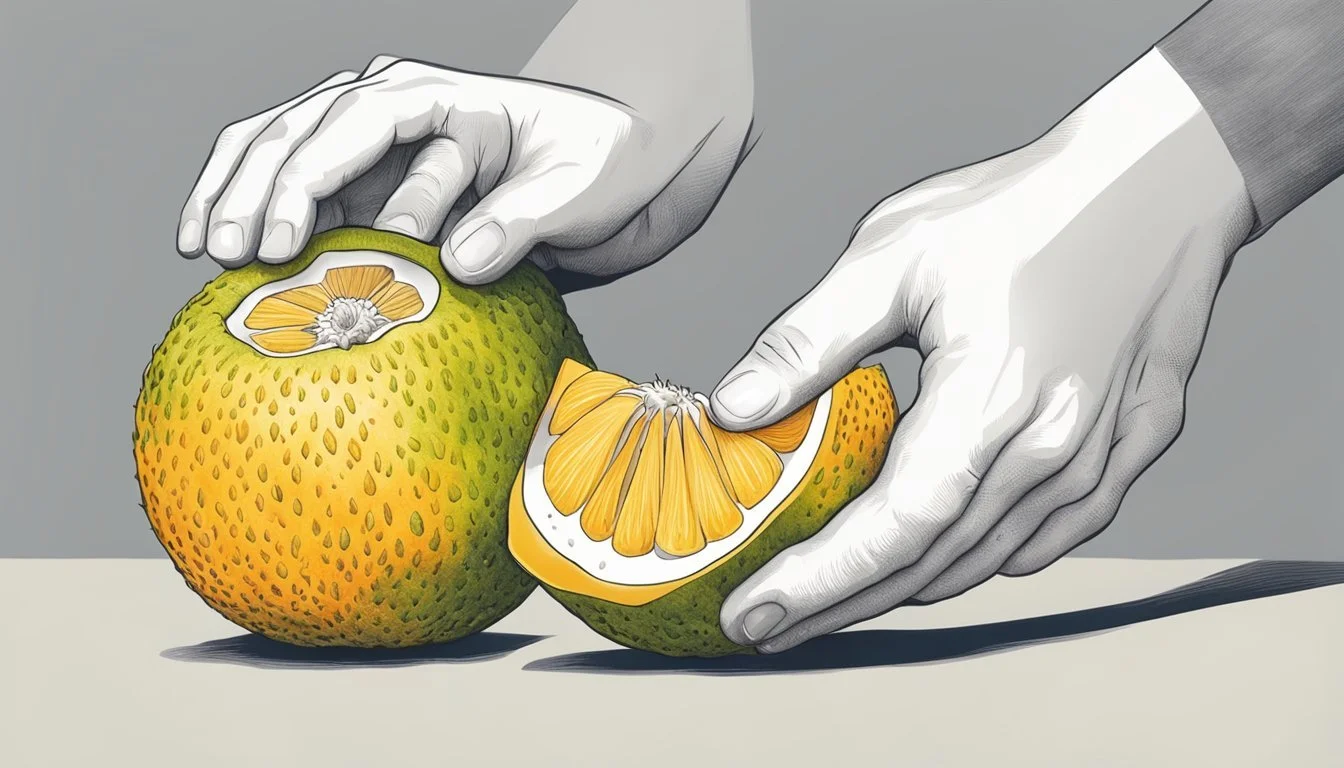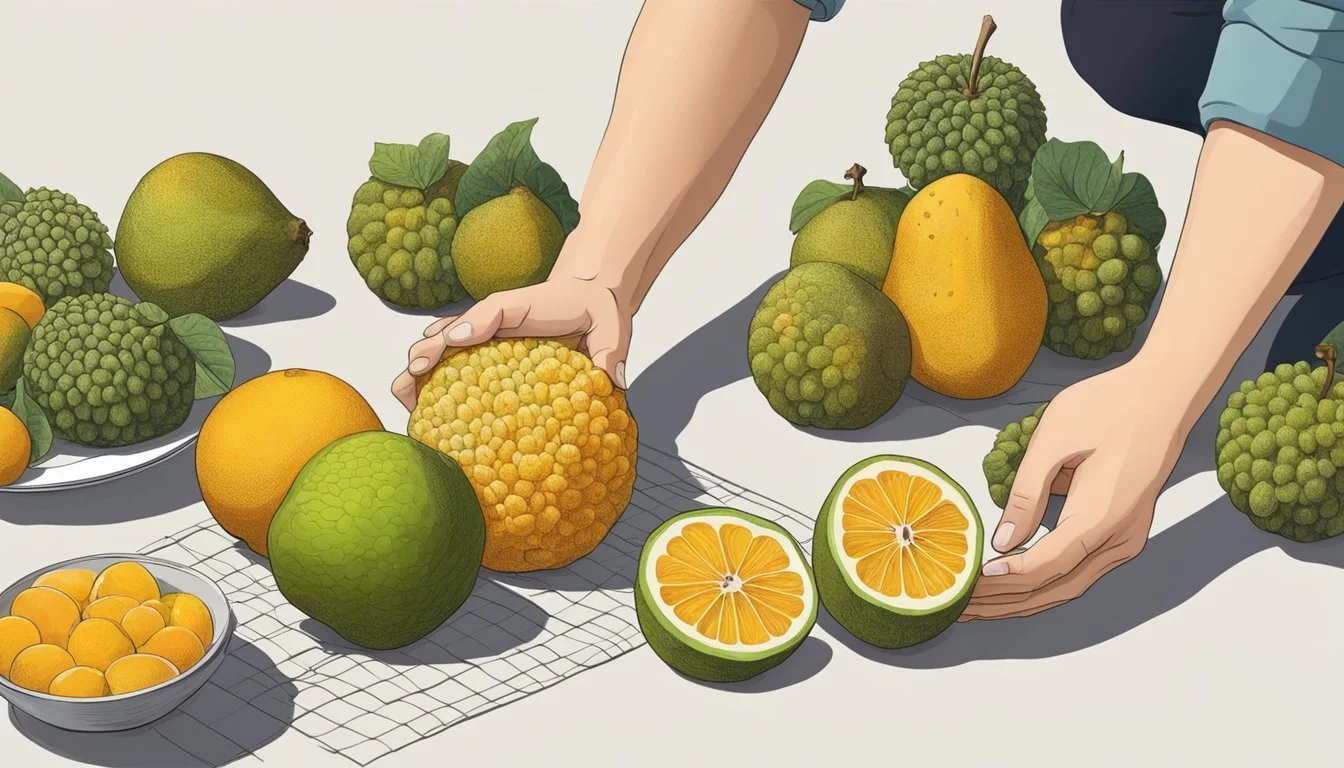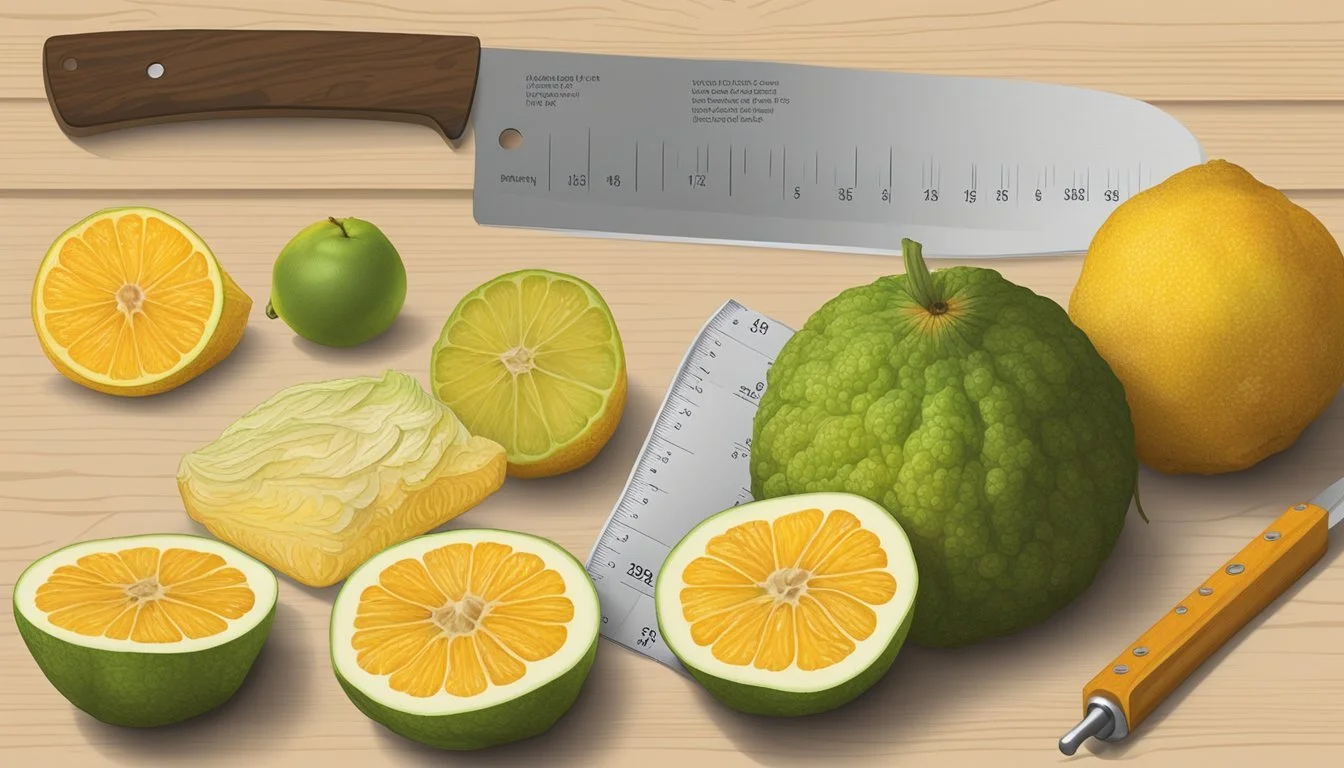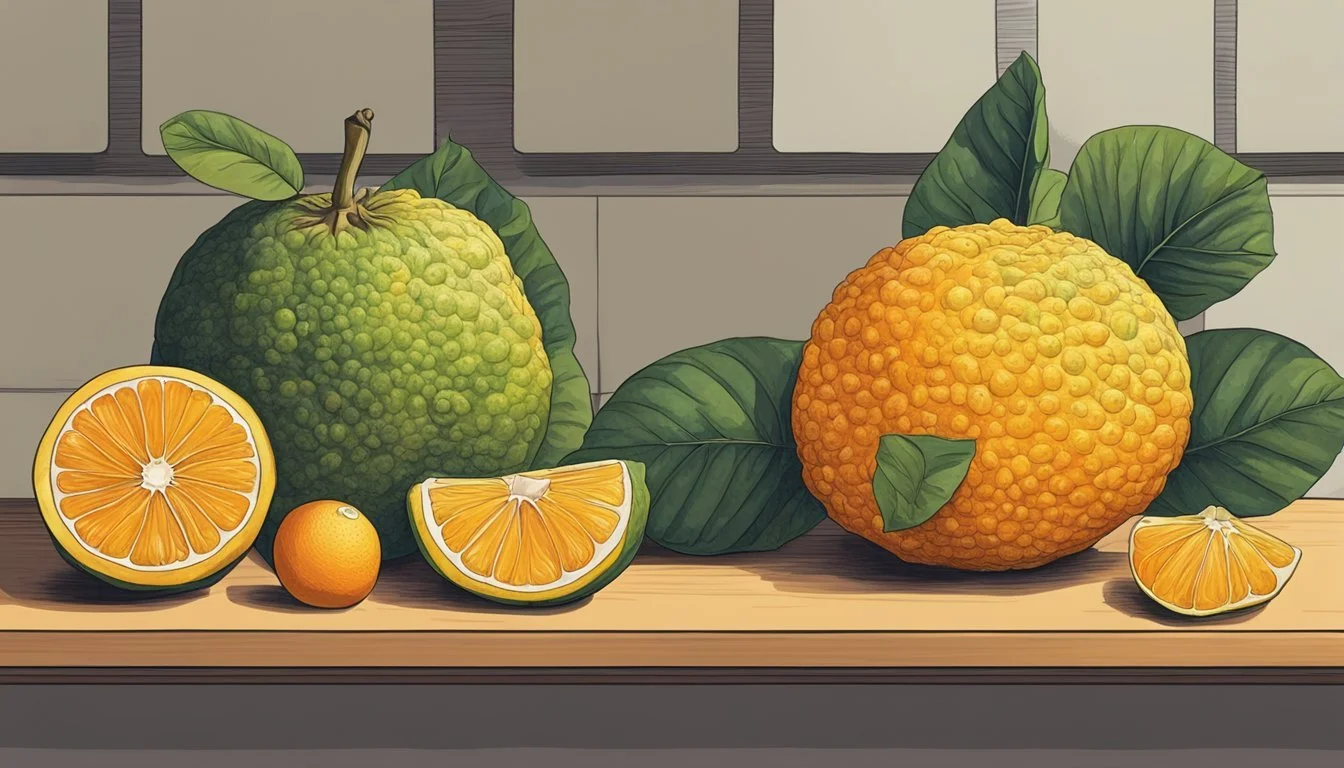How do You Eat an Ugli Fruit?
A Simple Guide to Enjoying This Exotic Citrus
The Ugli fruit (What wine goes well with fruit?), a unique hybrid citrus fruit hailing from Jamaica, surprises many with its distinct appearance and refreshing taste. It is a cross between a grapefruit, an orange, and a tangerine, resulting in an exterior that can appear somewhat wrinkled and greenish-yellow to pale orange in color. This intriguing characteristic is what many believe to have inspired its playful name: Ugli. However, its taste is anything but 'ugly', often being sweeter than a grapefruit with a tangy twist reminiscent of its citrus cousins.
Consuming Ugli fruit is straightforward and similar to enjoying other citrus fruits (What wine goes well with fruits?). The size and the taste of this fruit may vary, but its fleshier interior and sweet, juicy segments offer a pleasant eating experience. Despite the bumpy and tough skin, it's quite simple to access the fruit's succulent flesh by cutting it in half and using a spoon to scoop out the segments directly from the peel.
Navigating around the Ugli fruit's exterior to unveil its delectable insides introduces one to the delights of citrus varieties that are less common outside their country of origin. With its roots firmly planted in Jamaican soil, the Ugli fruit embodies the island's vibrant culture in every bite and brings a piece of its tropical heritage to kitchens around the globe. The method of indulging in this fruit taps into the broader appreciation for nature's ability to combine flavors and textures in extraordinary ways.
Identifying and Selecting Ugli Fruit
When searching for ugli fruit, a consumer should look for certain characteristics to ensure they select quality fruit. The ripeness and variety of the ugli fruit greatly influence its taste and suitability for consumption.
Assessing Ripeness
One should inspect the skin of the ugli fruit; a ripe fruit typically exhibits a greenish-yellow hue and may have mottled or slightly wrinkled skin. This appearance should not be mistaken for spoilage. The ideal ugli fruit will yield slightly to gentle pressure, indicating a ripe and sweet interior akin to that of a tangelo, a fellow citrus hybrid. Heaviness in hand suggests juiciness. Any fruit with soft spots or signs of drying should be avoided.
Understanding Varieties
Ugli fruit is itself a variety of tangelo, which is a hybrid of a grapefruit, orange, and tangerine, and it may vary in size and shape. However, the variations in appearance within ugli fruits are minor and primarily relate to size and the degree of greenish tint on the skin. One isn't likely to encounter multiple varieties of ugli fruit at the market due to its niche cultivation, thus selection frequently relies on personal preference for size and ripeness rather than specific cultivar differences.
Nutritional Profile
The ugli fruit stands out with its distinctive nutritional profile, particularly due to its vitamins and minerals, and its inclusion of dietary fiber and other essential nutrients.
Vitamins and Minerals
Ugli fruit is a rich source of vitamin C, which is crucial for immune function, skin health, and the absorption of iron from the diet. Here are some specific details:
Vitamin C: A half ugli fruit serving contains roughly 42 milligrams, which is about 70% of the daily value (DV).
Calcium: Provides approximately 20 milligrams of calcium (2% DV).
Potassium: The fruit also contributes to the daily intake of potassium, necessary for heart and muscle function.
Folate: Essential for DNA synthesis and repair, ugli fruit adds to folate intake, beneficial for pregnant women and overall cellular health.
Each of these vitamins and minerals plays a role in maintaining the body's health, and the ugli fruit provides a convenient source for them.
Dietary Fiber and Other Nutrients
Beyond vitamins and minerals, ugli fruit is beneficial for its dietary fiber and other nutrients:
Dietary Fiber: With 2 grams of fiber per 100 grams of the fruit, it aids in digestion and promotes satiety.
Protein: Despite being a fruit, it does offer a small amount of protein.
Antioxidant and Flavonoids: These compounds help the body fight off free radicals, potentially limiting oxidative stress and reducing the risk of chronic diseases.
Nutritional Value: Ugli fruit is low in calories, boasting only about 47 calories per 100 grams, making it a light, nutrient-dense snack option.
The presence of these nutrients makes the ugli fruit a valuable addition to a balanced diet.
Health Benefits
Ugli fruit is notable for its health-promoting nutrients that contribute to various aspects of well-being. It stands out with its high vitamin C content, dietary fiber, and an impressive array of antioxidants.
Weight Management
Ugli fruit is low in calories and contains dietary fiber which contributes to satiety and can help in weight management. The fiber content might also aid in reducing cravings, thereby preventing overeating.
Immune Support
Rich in vitamin C, a potent antioxidant, ugli fruit supports the immune system by protecting the body against free radicals. Vitamin C also plays an essential role in the synthesis of collagen, which is vital for skin and tissue health.
Heart Health
The inclusion of ugli fruit in one's diet may have benefits for heart health. The fruit's antioxidants, such as naringenin, have anti-inflammatory properties that can help in reducing the risk of heart disease. Furthermore, the fiber in ugli fruit can assist in lowering cholesterol levels, which is a contributing factor to heart disease and stroke.
Preparation and Consumption
Ugli fruit, a unique hybrid of grapefruit, orange, and tangerine, has a distinctive taste and requires a particular approach for peeling and segmenting before consumption. Such preparation maximizes the enjoyment of its juicy segments with ease.
Peeling and Segmenting
To begin, one should wash the ugli fruit thoroughly. Using a sharp paring knife, they cut the top and bottom off the fruit to create a stable base. Next, they score the skin from top to bottom, being careful not to cut into the juicy flesh. Gently, they pull the peel away, revealing the fruit inside. If the peel proves stubborn, they can use the knife to assist in removing it.
Segments of the ugli fruit can be loosened by carefully running the knife along the membrane to separate individual pieces. This process results in segments that are ideal for eating: tidy, flesh-rich, and mostly free of the bitter pith.
Eating Techniques
Once segmented, the ugli fruit is ready to be enjoyed. One common method is eating the ugli fruit with a spoon. They can cut the fruit in half across the middle and then eat the segments directly, using the spoon to scoop them out from the peel.
Alternatively, they may opt to eat the segments on their own, either with the hands or using utensils, much like they might consume orange segments. It's important to note that the fruit should be at room temperature to ensure that its flavors are at their most pronounced.
Culinary Uses
Ugli fruit is a versatile citrus with a unique flavor that lends itself well to both raw consumption and inclusion in various cooked recipes. It's especially appreciated for its juicy quality, which can enhance the taste of salads and desserts.
Raw Consumption
Ugli fruit is most commonly enjoyed raw, either as a snack or added to fruit salads. Here's how one might incorporate it:
Snack: Simply cut the ugli fruit in half, remove any seeds, and use a spoon to scoop out the fleshy segments.
Fruit Salad: Combine chunks of ugli fruit with other fruits like berries, apple slices, and a drizzle of honey for a sweet and tangy fruit salad.
Salad Addition: Adding segments of ugli fruit to a green salad can introduce a burst of juicy citrus flavor.
Cooking and Baking
Ugli fruit's distinctive taste also adds a twist to cooked dishes and baked goods:
Dessert: Ugli fruit segments can be included in citrus-based desserts, complementing with its sweet yet slightly tangy profile.
Smoothie: It can be blended into a fruit smoothie, mixing with other fruits and some honey for natural sweetness.
Stir-Fries: The fruit's juice and zest can be used in stir-fries to give a bright, citrusy note that pairs well with savory flavors.
Ugli fruit can therefore be used as a dynamic ingredient across various culinary applications, from refreshing snacks and salads to vibrant, flavor-enhancing additions in cooking and baking.
Sensory Experience
When consuming an ugli fruit, one embarks on a distinctive sensory journey that marries the flavors and textures of its citrus lineage. The experience is marked by a balance of sweetness and tartness, and a delightful juiciness that is paired with a subtle texture reminding the consumer of its citrus cousins.
Taste Profile
The ugli fruit is a unique citrus that inherits flavors from its parent fruits, the tangerine and grapefruit. What sets it apart is its sweet yet slightly tart flavor profile. A ripe ugli fruit exhibits a dominant sweetness with a mild tartness that is less intense than that of a grapefruit. Its fruity taste is more akin to an orange or tangerine but with a unique flavor twist that makes it distinct.
Texture and Juiciness
The texture of an ugli fruit is similar to that of a tangerine; it's tender and easy to separate into segments. It possesses a juicy quality that mirrors that of an orange, ensuring a satisfying and refreshing consumption experience. It's important to note that the peel of ugli fruit is typically thicker, which can slightly affect the textural experience.
Ugli Fruit in Diets and Health
Ugli fruit, a hybrid of grapefruit and orange, serves as a nutritious addition to various diets, providing high vitamin C content and a modest calcium boost. It is important to be aware of its potential effects on dietary restrictions, allergies, and medication interactions.
Dietary Restrictions and Allergies
Ugli fruit is generally suitable for most diets as it is low in calories and does not contain any known allergens found in other citrus fruits. However, individuals with citrus allergies should proceed with caution and may require an allergy test before consuming ugli fruit. For those with dietary restrictions:
Low-Calorie Diets: Ugli fruit, with its low-calorie count, fits well into a calorie-restricted diet.
Vitamin-Rich Diets: It is an excellent source of vitamin C.
Calcium Considerations: Offers a small amount of calcium, beneficial for bone health.
It is recommended that they introduce ugli fruit into their diet in small quantities to assess tolerance.
Interactions with Medications
Ugli fruit, much like grapefruit, contains compounds that can interact with certain medications, potentially leading to adverse effects. Specifically:
Coumarin-Based Medications: Individuals taking anticoagulants, such as those containing coumarin, should be cautious as ugli fruit can affect the medication's efficacy.
Diabetes Medications: People managing diabetes with medication must monitor their blood sugar levels as the fruit's natural sugars may impact glucose levels.
For those on medication, a discussion with a healthcare provider before adding ugli fruit to their diet is crucial. The healthcare provider can offer guidance on any potential drug interactions and ensure the safe consumption of ugli fruit in conjunction with their prescribed medications.
Storage and Shelf Life
Proper storage of ugli fruit is essential to maintaining its freshness and extending its shelf life. An ugli fruit can be kept at room temperature or refrigerated depending on how quickly it will be used.
At Home Storage
Room Temperature: Ugli fruit can remain fresh at room temperature for a few days. They should be kept in a cool, dry place away from direct sunlight to maximize this period.
Refrigerator: For extending the ugli fruit's shelf life, it is recommended to store it in the refrigerator. Ideally, the fruit should be placed in a plastic bag or container to retain its moisture and prevent absorption of other flavors. In the refrigerator, ugli fruit can last for up to two weeks.
Signs of Spoilage
Soft Spots and Mushiness: When ugli fruit begins to spoil, soft spots may develop on the skin, and the fruit may become mushy to the touch.
Appearance and Texture: A visual inspection for any discolorations or signs of mold should be performed. The fruit's texture should also remain firm and not squishy.
By being mindful of these storage conditions and signs of spoilage, one can ensure maximum enjoyment of their ugli fruit.
Cultural and Economic Impact
The ugli fruit, often recognized under the brand name Uniq Fruit, has both cultural significance and economic implications, primarily as a product of Jamaica with commercial reach extending to European supermarkets and beyond.
Historical Significance
The ugli fruit, or the Jamaican tangelo, is a hybrid citrus fruit believed to have been discovered accidentally. The fruit is thought to have originated when a grapefruit was cross-pollinated with a tangerine or orange tree. It was first found growing wild in Jamaica in the early 20th century and has since become an integral part of Jamaican agricultural heritage. The first person to begin commercial cultivation was G.G.R. Sharp, and the brand name under which it is widely marketed today is "Ugli," a name that plays on the fruit's distinctive, irregular appearance.
Commercial Production
Commercial production of the ugli fruit is significant in Jamaica, where it is grown predominantly. The trees on which the fruit grows are evergreen, enabling them to produce fruit mainly in the spring and fall when other citrus fruits are not in peak season. This characteristic provides Jamaican farmers with a unique market opportunity. Ugli fruits have also made their way into European supermarkets, signaling their acceptance and growing popularity beyond Jamaica's borders. The sale of ugli fruits contributes to Jamaica's economy, and the uniqueness of the product holds potential for further economic development through exportation.
Comparing Ugli Fruit with Other Citruses
The ugli fruit stands out among citruses for its unique hybrid qualities, comprising features of grapefruit, orange, and tangerine. This section examines how the ugli fruit compares to other citrus fruits in terms of nutrition and taste.
Nutritional Differences
Ugli Fruit: A hybrid of tangelo, the ugli fruit’s nutrition closely aligns with oranges and grapefruits. It's particularly rich in vitamin C and dietary fiber.
Vitamin C: Provides approximately 70% of the Daily Value (DV) per serving.
Calories: Lower in calories compared to oranges.
Grapefruit (Citrus paradisi): Known for its vitamin A and C content, grapefruits offer a robust nutrient profile including potassium and dietary fiber.
Vitamin A: Essential for vision and the immune system.
Calories: Comparable to ugli fruit, but sizes can vary.
Orange: This popular citrus fruit is also high in vitamin C and provides significant potassium, calcium, and vitamin A.
Sweetness: Generally sweeter than grapefruits and some tangelos, making it a favorite.
Tangerine/Mandarin Orange: These are smaller and sweeter than most of their citrus cousins and are known for their easier peel.
Vitamin C: Slightly less than oranges but still a good source.
Taste Variations
Ugli Fruit: Flavor profiles can range from sweet to slightly tart, reflecting its genetic blend. The taste is often less bitter than a grapefruit and generally milder than a lemon.
Grapefruit: Known for its blend of sweetness and tartness, grapefruit can be more bitter and sour than ugli fruit.
Orange: Typically the benchmark for sweetness in citrus fruits, providing a consistent and familiar taste that is less tart than grapefruit.
Tangerine/Mandarin Orange: As the sweetest among common citrus fruits, these are less acidic and have a warmer, spicier undertone.
Conclusion
Eating an ugli fruit is a simple yet delightful experience. To savor its unique flavor, one should first cut the fruit in half. Then, using a spoon, the segments can be easily loosened and enjoyed directly from the peel. For a more refined approach, a sharp paring knife comes in handy to peel off the rind and reveal the succulent flesh underneath.
Ugli fruit offers a medley of nutritional benefits, being rich in vitamin C and low in calories. It stands as a hybrid between an orange and a grapefruit, and this genetic combination endows the ugli fruit with a distinctive taste as well as a potent blend of nutrients.
Here's a brief overview of the steps to enjoy an ugli fruit:
Prepare the Fruit: Wash and pat dry with a soft cloth.
Peel or Cut: Use a knife or spoon based on your preference.
Enjoy: Eat the ugli fruit as it is, or add it to salads, juices, or desserts.
This citrus fruit may be named 'ugli', but its nutritional profile and versatility in different culinary uses make it anything but unappealing to the health-conscious food lover. Whether consumed on its own or incorporated into dishes, the ugli fruit is surely a remarkable addition to your diet.







